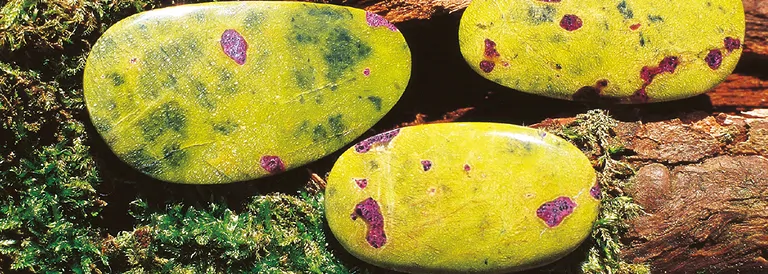
Stichtite - Meaning, effect and application
In turbulent time brings us the Stichtit gentleness and inner peace. With composure, but still full of determination the necessary measures can be taken to reach our goals. Just as the greening nature lets forget the darkness of winter forgotten, we can also leave our worries behind us. Together with Serpentine, stichtite encourages us to make and implement decisions without losing our composure and peace of mind. Peace of mind to lose.
Mineralogical profile stichtite
Chemical formula: Mg6Cr[(OH)16/CO3] x 4. H2O
Class of minerals: basic hydrous Hydroxide carbonate
Color: pink to purple, brown
Gloss: Wax or grease luster
Crystal system: trigonal
Mohs hardness: 2 to 2.5
Cleavability: no cleavability, fracture uneven
Localities: mainly Australia (Tasmania), South Africa and Canada; further localities of stichtite are in Austria, Russia, Morocco, India, New Zealand and Mexico.
Formation: secondary or metamorphic alteration product of chromium-bearing Serpentinite rocks. Stichtite often grows in the parent rock Serpentine. This combination is also known under the name atlantasite and atlantisite (not to be confused with Atlantis stone, a trade name for Larimar) in the trade. You can also find stichtite together with white calcite, antigorite and barbertonite.
Synonyms, trade names: chrome brugnatellite, atlantasite and atlantisite (for stichtite in Serpentine), tasmanite (for stichtite from Tasmania only)
Stichtite items like tumbled stones, focal components and bracelets at wholesale prices

Historical facts about stichtite
Stichtite was discovered in Tasmania (Australia) in 1910. It received its name from the American metallurgist. Robert Carl Sticht (1856 - 1922), who was also active in Australian mining. The place of the first discovery is known today as Stichtit Hill. In former times it was processed only very rarely as a gemstone, only since 2004, it is more often available as a gemstone or healing stone in the trade.
Stichtite items like tumbled stones, focal components and bracelets at wholesale prices
Violet - the color of stichtite
Violet in various shades is the predominant color of stichtite. Purple is the color of Spirituality, has a meditative effect and is considered a healing color of the spirit. The energy of violet is liberating, purifying and dissolving, brings mental peace and serenity. Memories, inventiveness and awareness are strengthened. Primal knowledge is awakened and promotes the reception and exchange of information.
Usage of Stichtite in gemstone healing
Stichtite is a stone of inner peace and emotional openness. He calms upset tempers and brings relaxation. From a serene state, new forces are mobilized. The energy of stichtite is gentle, but at the right time it can help to bring forward big and important decisions. In times of upheaval, stichtite brings steadfastnesst.
In combination with calcite, one can that the development-accelerating, steadfastness and self-confidence supporting effect of the Calcit with the typical effect characteristics of the Stichtit harmoniously supplements itself. Researches of the stone medicine do not exist however, not yet, because the stichtite is a comparatively new healing stone.
Stichtite items like tumbled stones, focal components and bracelets at wholesale prices
Combination Stichtite and Serpentine
The purple stichtite is often found in combination with the green serpentine, a both visually and energetically attractive intergrowth of two minerals with similar spectrum of action, which complement each other harmoniously complement each other. Stichtite in Serpentine is also called Tasmanite; this name should be be used exclusively for stichtite, which is found in Tasmania.Both serpentine and stichtite Convey balance and inner peace. Stichtite in Serpentine is an ideal stone for contemporaries with a quick-tempered and lacking patience. He calms, relaxes and helps to find the inner center again. to find.
Confusion and discernment of Stichtite
Stichtite can be confused with Charoite and Sugilite. The easiest way to distinguish them is by the low Hardness of stichtite (Mohs hardness 2 - 2.5), compared to Charoite (hardness 5 - 6) and Sugilite (hardness 5.5 - 6). Charoite and Sugilite show Glass to silky luster, while Stichtite has a matte surface. Mostly the violet color of stichtite is also more homogeneous than that of Charoite and Sugilite.
